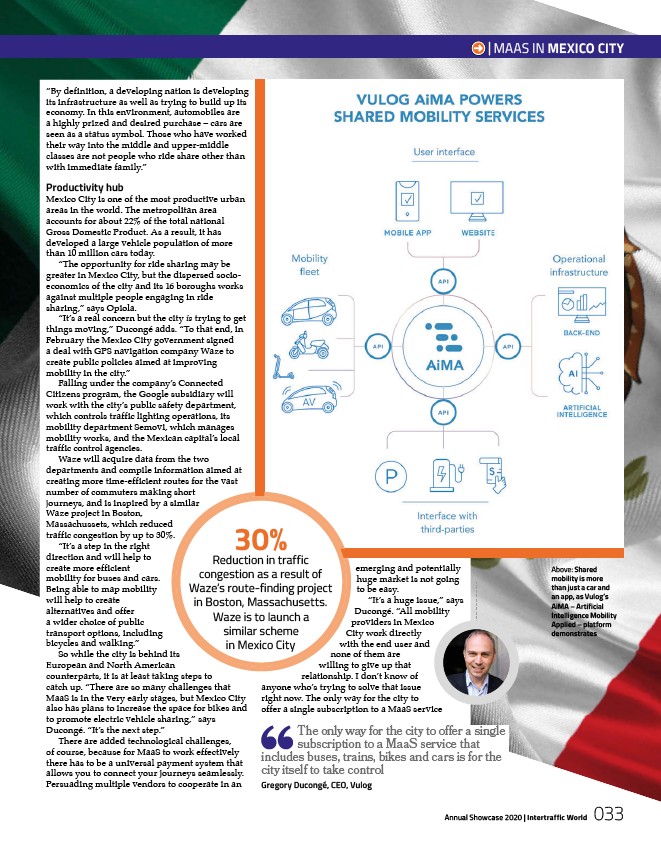
|MAAS IN MEXICO CITY
Annual Showcase 2020 | Intertraffic World 033
“By definition, a developing nation is developing
its infrastructure as well as trying to build up its
economy. In this environment, automobiles are
a highly prized and desired purchase – cars are
seen as a status symbol. Those who have worked
their way into the middle and upper-middle
classes are not people who ride share other than
with immediate family.”
Productivity hub
Mexico City is one of the most productive urban
areas in the world. The metropolitan area
accounts for about 22% of the total national
Gross Domestic Product. As a result, it has
developed a large vehicle population of more
than 10 million cars today.
“The opportunity for ride sharing may be
greater in Mexico City, but the dispersed socioeconomics
of the city and its 16 boroughs works
against multiple people engaging in ride
sharing,” says Opiola.
“It’s a real concern but the city is trying to get
things moving,” Ducongé adds. “To that end, in
February the Mexico City government signed
a deal with GPS navigation company Waze to
create public policies aimed at improving
mobility in the city.”
Falling under the company’s Connected
Citizens program, the Google subsidiary will
work with the city’s public safety department,
which controls traffic lighting operations, its
mobility department Semovi, which manages
mobility works, and the Mexican capital’s local
traffic control agencies.
Waze will acquire data from the two
departments and compile information aimed at
creating more time-efficient routes for the vast
number of commuters making short
journeys, and is inspired by a similar
Waze project in Boston,
Massachussets, which reduced
traffic congestion by up to 30%.
“It’s a step in the right
direction and will help to
create more efficient
mobility for buses and cars.
Being able to map mobility
will help to create
alternatives and offer
a wider choice of public
transport options, including
bicycles and walking.”
So while the city is behind its
European and North American
counterparts, it is at least taking steps to
catch up. “There are so many challenges that
MaaS is in the very early stages, but Mexico City
also has plans to increase the space for bikes and
to promote electric vehicle sharing,” says
Ducongé. “It’s the next step.”
There are added technological challenges,
of course, because for MaaS to work effectively
there has to be a universal payment system that
allows you to connect your journeys seamlessly.
Persuading multiple vendors to cooperate in an
30% Reduction in traffic
congestion as a result of
Waze’s route-finding project
in Boston, Massachusetts.
emerging and potentially
huge market is not going
to be easy.
“It’s a huge issue,” says
Ducongé. “All mobility
providers in Mexico
City work directly
with the end user and
none of them are
willing to give up that
Waze is to launch a
similar scheme
in Mexico City
relationship. I don’t know of
anyone who’s trying to solve that issue
right now. The only way for the city to
offer a single subscription to a MaaS service
Above: Shared
mobility is more
than just a car and
an app, as Vulog’s
AiMA – Artificial
Intelligence Mobility
Applied – platform
demonstrates
The only way for the city to offer a single
subscription to a MaaS service that
includes buses, trains, bikes and cars is for the
city itself to take control
Gregory Ducongé, CEO, Vulog